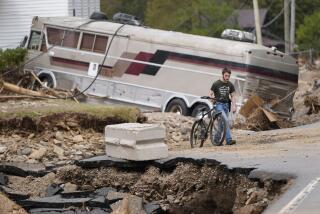Rain thwarts Colorado air rescues
FORT COLLINS, COLO. — As rain continued for a seventh day, inundating much of the state and creating a virtual moat around the closed Rocky Mountain National Park, Sandra Ellison waited at the Timberline Church here Sunday for the helicopters that would evacuate her parents, 86 and 85.
But choppers couldn’t operate in the torrential rain and heavy clouds. Her parents would have to wait another day to escape their flooded, remote community near Glenhaven. Like many others in Colorado, they remained trapped inside a slow-motion disaster that has washed out roads, broken bridges from their embankments and separated families.
“I just wanted to be here when they got off the helicopter,” Ellison said.
Maybe the helicopters will come Monday. If the fog lifts. If the rain stops.
More than 16 inches of rain have fallen across parts of the heavily populated Front Range in the last week, triggering flash flooding exacerbated by wildfire scars in forestland. In Boulder, the total rainfall has reached nearly a year’s worth.
Even as more wretched weather hampered the aerial rescue effort, the disaster came into clearer focus Sunday as officials tallied the losses.
Five people have been confirmed dead, a number expected to rise as hundreds of U.S. Army and National Guard rescuers help local officials pick through the 1,502 residential structures destroyed by torrents of rainwater and mud.
According to the Colorado Department of Emergency Management, 17,494 more buildings have been damaged and 11,700 Coloradans have been forced to evacuate -- a displacement that has added to the worry.
One ominous estimate looms over the rescue effort: 1,253 people had not been accounted for as of Sunday evening, a shifting tally that has grown as flooding has persisted.
In many disasters, the number of those unaccounted for tends to start high and drop as people are reunited. But this crisis has prolonged the uncertainty -- often to great pain.
One of the worried people was Leigh Rohrig, who got a call from her boyfriend at 6:30 a.m. Thursday. Nathan Protsman said the meadow behind his Estes Park house was flooded and water was rising fast.
He sounded nervous, she said. Five hours later, he sent a text saying he was packed and ready to evacuate with their dog, Kaya, if necessary: “I’m at work. Everything’s good.”
But when she tried to call him back soon after, his phone went to voice mail. She tried calling his workplace, an outdoor gear supply store in the resort town, a gateway to Rocky Mountain National Park. A message said the phone had been disconnected or was no longer in service.
By the middle of the afternoon, she had one hand on her phone, the other on the television remote. She was glued to the terrible images of buckled highways and raging waters. Most of the coverage was centered in Boulder County, but Estes Park is in Larimer County. The only picture she saw was a town underwater. She was terrified.
Finally, at 9:30 a.m. Friday, she got an email. The subject line: “I’m OK.”
“I just started bawling,” she said.
Gov. John Hickenlooper, appearing Sunday morning on CNN, expressed hope that many of the missing were simply out of reach of communications and had “already gotten out or [are] staying with friends.”
“But we’re still bracing,” he added. “I mean, there are many, many homes that have been destroyed.”
One of them, in Larimer County, was thought to be the site of a sixth fatality, as yet unconfirmed. John Schulz, public information officer for the county, said an 80-year-old woman was injured and unable to get out of her house as floodwaters began engulfing it. When neighbors returned to help, her house was gone.
In all, 15 counties have been affected. In Boulder, Larimer and Jefferson counties alone, the flooding has damaged about 2,400 square miles, according to state officials.
“I can tell you, while I felt hopeless on Friday, I felt a lot of hope, a lot of energy, yesterday,” Larimer County Sheriff Justin Smith told reporters Sunday as he reviewed the efforts of the National Guard, utility workers and emergency officials.
An emotional Smith said communities would come back from the disaster “inch by inch, mile by mile, community by community.”
“They’re doing it,” Smith said, his voice breaking. “People are getting those things done out there.”
--
Special correspondent Deam reported from Fort Collins and Times staff writer Pearce from Los Angeles.
More to Read
Sign up for Essential California
The most important California stories and recommendations in your inbox every morning.
You may occasionally receive promotional content from the Los Angeles Times.











